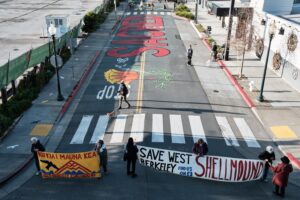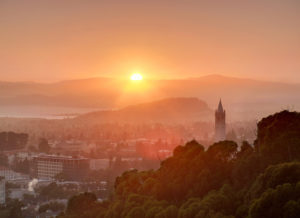You probably felt only three or four of them, but there have actually been 16 brief rumbles along the Hayward Fault in the last week in Berkeley. As little quakes tend to do in Earthquake Country, these have shaken the idea of the Big One loose from its usual obscurity and brought it to the front of everyone’s minds.
And for good reason. The US Geological Survey estimates that of the seven faults most likely to generate a magnitude 6.7 or larger earthquake in the Bay Area, there’s a 63 percent chance that at least one of them will break in the next 26 years. There’s a 31 percent chance that it will happen along the Hayward Fault, the greatest chance of the seven. The fault runs for 74 miles along the western base of the East Bay Hills from San Jose to San Pablo Bay.
Even though these minor quakes get everyone talking about “The Big One,” seismologist Peggy Hellweg, at the Berkeley Seismology Lab, says they’re nothing abnormal and don’t significantly lessen the strain on the Hayward Fault. In fact, so little is known about earthquake dynamics, seismologists can’t say whether little quakes like these increase or decrease the probability of an imminent big one.
Since the initial magnitude 4 quake on October 20 at 2:41 p.m., 15 smaller aftershocks rocked from epicenters within a half mile radius in Berkeley, all occurring about five miles below the surface. Four of the larger shakes, including the initial bigger one, span a line along the fault at almost equidistant points as the crow flies between People’s Park and the intersection of Claremont and College avenues.
These clustered quakes are not uncommon in the Berkeley area, says Hellweg. Certain areas along the fault are more prone to clustered mini-quakes, possibly due to a heightened tension from slight bends in the fault.
These quakes, and the coming large one, will be the result of the tension borne from the continued northwestward movement of the Pacific tectonic plate against the North American plate. In the Bay Area, their border roughly follows the California shoreline, with the Pacific plate moving northwest at about a rate of 40 millimeters a year. The Pacific side of the Hayward Fault creeps at about 4 millimeters a year (about little more than a quarter inch), but would need to slip at least 10 millimeters a year to prevent the tensional buildup that will result in the magnitude 6.7+ monster quake. When it finally does break, land on either side of the fault is expected to displace about six feet!
The last big quake on the Hayward Fault occurred on October 21, 1868, 143 years ago (check out Bay Nature’s 2008 feature on that). The prediction for the fault’s next big quake emerges, in large part, from the fact that the last five big Hayward Fault earthquakes broke on average once every 140 years. So, it’s time to get going on your earthquake emergency plan! Get the skinny at shakeout.org. And find a good list of resources here.
If all this geology talk has you thirsting for more, be sure to read our 2006 section all about the San Andreas Fault and plate tectonics. And check out our January 2013 story on the geology of the East Bay hills!

.jpg)


-300x96.jpg)
